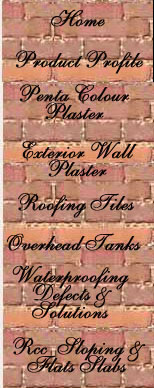|
PROBLEMS
IN CONVENTIONAL & CHEMICAL WATERPROOFING TECHNIQUES
-
No treatment
is available to fill up the honeycombing that is present in
most concrete slabs, especially sloping slabs. This is a primary
cause of leakage as trapped air gets heated during the day,
expands and escapes making way for the entry of water.
-
Thermal
expansion and contraction (occuring daily from mid day to night)
of concrete and of masonry are not dealt with. This is the second
reason for the appearance of cracks which cause leakage of water.
-
Exposed
horizontal surfaces of concrete unless painted over, get eroded
and appear sandy due to the effect of dew which is acidic in
reaction today.
-
Masonary
parapets crack at regular intervals through which water seeps
in.
-
Rods, pipes,
wires projecting out of the concrete/masonry structure crack
at the junction due to differential thermal expansion. No proper
treatment is available to overcome these cracks.
-
Chemical
waterproofing blocks the porosity of the treated surface, preventing
the structure form breathing air and water vapour. This trapped
air within the coating expands in the hot sun, forming bubbles
which ultimately burst and peel off the surface, leading to
leakage.
-
Most commercial
additives to cement make it strong and rigid. In dry conditions,
this resists thermal expansion, which in turn cracks the surface
through which water seeps in.
-
Chemically
treated surfaces get ruptured with normal movement over them.
-
In existing
buildings cracks which appear especially on the West and South
walls should not be filled by gravity or direct pump injection
of cement slurry alone as this makes the structure rigid and
it tends to give way to cracks elsewhere.
-
Waterproofing
of expansion joints by simply putting flexible fillers grip
only at the surface. This can easily rupture and allow rain
water to enter.
-
Water tanks
made of cement concrete get eroded from inside by the chlorine
present in water.
-
All types
of windows, especially those made of aluminium are very difficult
to waterproof where rain and wind pressure are the maximum,
and especially if no chajja is provided over the window.
-
Existing
bathrooms, open balconies and terraces which have developed
leakages from the floor, walls or pipes are normally waterproofed
by ripping off the tiles. These can be waterproofed by our system
at a very competitive rate, in two days without disturbing the
tiles.
-
Curing
is intermittent.
OUR FOOLPROOF WATERPROOFING SOLUTIONS FOR
NEW & OLD CONSTRUCTIONS
-
Honey combing
in RCC structures and masonary are injected with cement slurry
pneumatically at low velocity but high pressure after vacuuming.
-
Thermal
expansion and contraction of concrete and of masonry is existing
buildings are also injected pnuematically with a flexible
cement mix.
-
All
exposed surfaces of concrete and masonry are ocovered with a
flexible layer of cement mortar which is resistent to a pH of
5.5.
-
Cracks
appearing in masonry parapets of existing buildings are pneumatically
injected with a flexible cement slurry. For new buildings, compaktuna
must be added to the mortar.
-
Rods,
pipes wires projecting out of the concrete/masonry structure
are joint by a graduated joining process.
-
Compaktuna/silicones
mixed in cement mortar allow the structure to breathe by allowing
air an water vapour to move in and out of the structure, but
do not allow water (having a larger molecular structure) to
enter.
-
The
cement mix can expand and contract to a great extent in heat/cold
conditions tolerating about a million cycles.
-
As the
thickness of the waterproof layer is 2 to 3 cms. and it even
penetrates the concrete/masonry, there is no question of failure
even if pedestrian traffic moves on the surface.
-
In existing
buildings, cracks which appear, especially on the West and South
walls are filled by pneumatic injection of a flexible cement
slurry allowing for thermal expansion.
-
Expansion
joints are fully filled with a highly flexible silicone mix
which grips the opposite surfaces by a deep and penetrating
bond, bottom and top cladding is provided.
-
Water tanks
made of cement concrete are protected by a 2 cms. layer which
withstands a pH of 5.5 to 14.
-
Existing
bathrooms, open balconies and terraces which have developed
leakages from the floor, walls or pipes are waterproofed by
our system in two days without disturbing the tiles, at a very
competitive rate by a water tight barrier process.
-
Curing
of the waterproofing is done mechanically and continously, even
on a sloping slab for a period of ten days.
|


